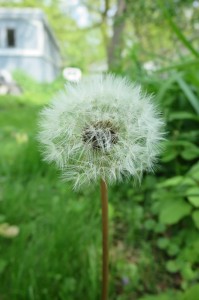You might have seen a piece of news recently about allowing dandelions to grow to help bees survive, especially in early spring.
As a homeowner with a front yard that right now is bursting with dandelions, I’d have to agree with that reasoning, or whatever else supports the current look of my lawn.
“Farmer Dave” Miller of the Mount Vernon Farmers Market offers his own take on the bee-friendly tip. Remember, the Mount Vernon market runs 4-6 p.m. Thursdays at the Community Center in Mount Vernon. Find a list of more than 50 Eastern Iowa farmers markets here and read on for more from Farmer Dave:
Do you like food? I bet you do.
I don’t have any science to back up my recent discovery that humans, on average, like food, but I am fairly certain about my belief. It is odd then that a lot of humans like to kill dandelions, violets and creeping Charlie, because they are extremely important to the creation of things like coffee, ice cream sandwiches and beef jerky—you know, the staples of life. And jalapeno peppers. Don’t forget the jalapeno peppers.
Early in spring, bees are hungry and there is little out there except the wildflowers I mentioned above. And without bees, we won’t have nearly as much processed spreadable cheese, beer and hard salami.
Oh yeah—and nearly all the fruits and vegetables on Earth.
I’ll be the first to admit I love the smell of 2,4-D—the most commonly used chemical to destroy wildflowers in lawns. 2,4-D is one of the scariest garden chemicals out there, I despise the thought of it on my own property, but I absolutely love its odor. I bet you do, too. It is one of the main ingredients in the “perfume” that pleasantly assaults your olfactory senses when you walk through the door of a garden center.
Cedar chips, onion bulbs and a poison derived from the process that gave us Agent Orange makes up that intoxicating aroma that, let’s face it, would make an irresistible unisex cologne. But I digress.
2,4-D kills everything but grass, and lawn treatment companies are required to post signs warning you not to walk on the lawn after spraying. If a homeowner using the service is lucky, the guy spraying (who is earning approximately minimum wage) shows a little care around trees and shrubs, but most likely, he will not. You show me a house with a spray-type lawn care service and I’ll show you neighbors who have no fruit trees or grapevines.
So I say, if you do indeed like food, let those lawn weeds flourish. You can even mow the lawn a little less often to keep the flowers intact. Lawn mowers are terrible polluters anyway—much worse than automobiles when engine size is taken into account. According to the University of Kansas, one hour of lawn mowing equals 40 hours of car driving when it comes to emitting environmental poisons. Assuming 75 percent of Mount Vernon households have lawns that get mowed weekly, then after 20 weeks (June to October) the town of Mount Vernon, Iowa, puts out the emissions equaling 780,000 hours of automobile driving. Assuming an average auto driving speed of 35 miles per hour, that’s the equivalent of 27,300,000 miles driven—all just to cut the grass in our tiny whistle stop.
You can reduce emissions by half by mowing the front yard one week and the back the next.
In my opinion, a lawn is just an indicator that you aren’t growing enough fruit, vegetables and flowers anyway. Look around and you’ll see perfect patches of grass abutting storm sewer drains. In Iowa, these are man-made tributaries to the Mississippi. What we put on our lawn is washed to the driveway, out into the street, to the storm sewer, eventually to a nearby creek (that makes us feel less guilty when we call it a drainage ditch) then to a river, then into the Mississippi and finally to the Gulf of Mexico. Yes it is true: Homeowners put more chemicals on lawns, per square foot, than farmers put on their fields. That’s a scary thought, isn’t it? And for grass that is largely ornamental.
Blame it on the French. A couple hundred years ago the French aristocracy decided to show the world they were so rich that they could grow grass for no reason. They could waste farmland. So they planted giant lawns around their estates. The fad caught on and that’s really the only reason why we have grass in front of our houses.
Here’s a tip for lazy people who don’t want to deal with lawn care. Kill all of your grass. Then plant white Dutch clover. All you have to do is sprinkle the seed on top of the soil in the spring or fall. You don’t even have to move a rake around to cover it. White Dutch is a perfect bee forage, creates its own fertilizer from the air and you’ll only have to mow it a couple of times per year. It’s not a bad idea for people who like food, too. Do you know anyone who likes food? I bet if you think real hard, you do.
Or you could be like me and let the lawn go until dandelion seed heads form. I’m lazy for the bees. I also haven’t fixed the gutters for the bees or painted the shed for the bees. At least that’s what I’m telling my wife.
See you at the market.
Farmer Dave


No Comments Yet